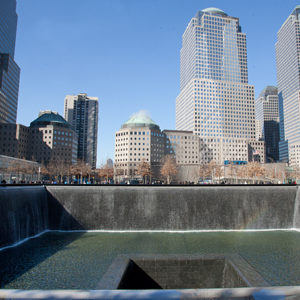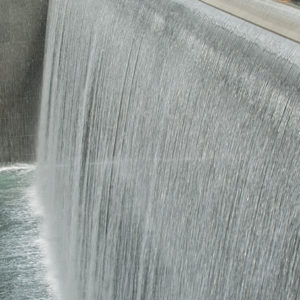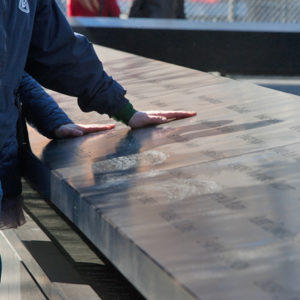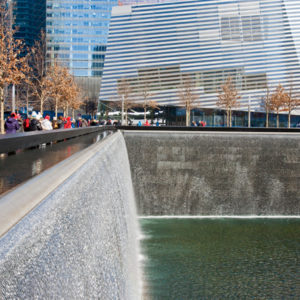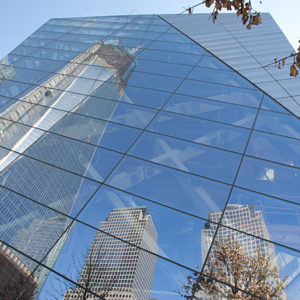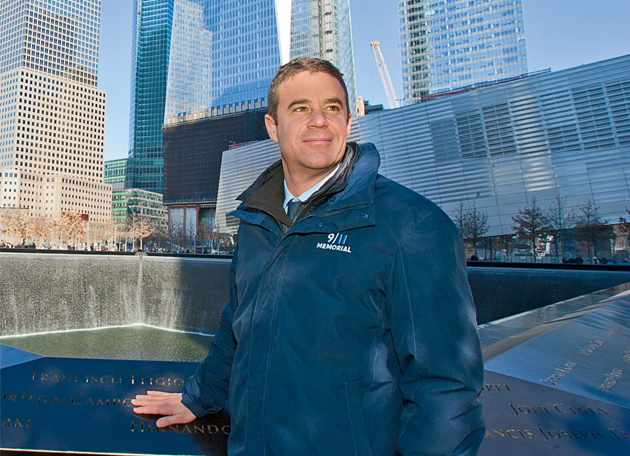
Hurrying to a business appointment near the World Trade Center on Sept. 11, 2001, attorney Joe Daniels, AB ’94, had just raced up the subway steps from the downtown E train to the street. He was near the foot of the Twin Towers — the world’s tallest buildings when completed, structurally buttressed against strong winds and designed by an architect who believed world trade meant world peace. The North Tower was stricken: Black smoke was pouring from a massive tear in its side; thousands of office papers were drifting down from the sky. From a hundred stories up, people were falling.
Minutes later, a fireball exploded from the second tower in a blinding flash of light. After a split second of silence, a deafening roar ripped through Lower Manhattan. People started running. Making his way to his home in Greenwich Village, Daniels heard about the attack on the Pentagon and wondered if the country was being invaded. Then, crossing northeast through Washington Square Park, he heard screams behind him. He turned and saw the South Tower collapsing on itself, transmuting story by story into a monumental billowing pillar of dust.
In all, four attack planes killed 2,977 sons, daughters, husbands and wives in New York City; Washington, D.C.; and Shanksville, Pa., on Sept. 11. More than eight years earlier, in the first attack on the World Trade Center on Feb. 26, 1993, six people died and more than a thousand were injured. The memorial has the names of victims of all three attack sites and the 1993 bombing.
On Sept. 11, more than 90 countries lost citizens, with the greatest loss coming from the United States. Adults in the 35- to 39-year age range were among the largest number of people killed.
That apocalyptic day and its harrowing aftermath convinced Joe Daniels, JD, to find work with a different kind of mission. At the time, he was a consultant at McKinsey & Co., following two years as an associate at the prestigious New York law firm Cravath, Swaine & Moore.
Daniels found the purpose he sought at the Robin Hood Foundation, which targets poverty in New York City. As its chief of external initiatives, he led the expansion and rollout of phase two of a $45 million public-private library partnership.
“I knew right away that if I had a chance to be involved in something that meaningful, I would do it in a heartbeat.”
—Joe Daniels
Then, in 2005, Daniels learned that a new organization, the National September 11 Memorial and Museum, was searching for staff. “I knew right away that if I had a chance to be involved in something that meaningful, I would do it in a heartbeat.” He signed on as general counsel and later ran the foundation on an interim basis. When the founding chairman moved on, New York Mayor Michael R. Bloomberg stepped into the position; in October 2006, he appointed Daniels permanent president and CEO.
Keenly intelligent, highly charged and open-hearted — and like so many New Yorkers, proficient at speaking presto — Daniels forgoes Joseph for Joe because “that’s been my name ever since I stopped being Joey in the sixth grade.” The man who directs planning, construction, development and operations for the memorial and museum projects works comfortably with Bloomberg, who “sets incredibly high expectations and then gives people the latitude to deliver.” And deliver Daniels does — sensitively and thoughtfully in his city of vociferously dueling constituencies that on 9/11 found common ground in their horror, outrage and grief. Millions of people, across the five boroughs, the nation and the world, remain emotionally invested in his results.
A transformation
The 9/11 Memorial opened on schedule on Sept. 11, 2011, to the victims’ families during a 10-year anniversary ceremony. It opened to the general public the following day to a reaction Daniels calls phenomenal. Looking out on the memorial that millions have already visited, he explains that the progression of images in collective memory — attacks, death and destruction, dust and debris, the very difficult recovery and nine-month cleanup, and the terrible pit at Ground Zero — “comes to a final stop in the site’s absolute transformation to this beautiful place.”
Created by architects Michael Arad and Peter Walker, the design eclipsed more than 5,200 entries from 63 nations. On the eight-acre site, hundreds of white oak trees surround two enormous reflecting pools placed exactly where the Twin Towers stood. Each footprint is nearly an acre in size and 30-feet deep into the plaza. Framed in bronze, the largest man-made waterfalls on the continent shimmer down the footprints’ eight sides. Deeply etched into the classic bronze are the names of every person identified who died in the 2001 and 1993 attacks. The gentle waters and hewn inscriptions surrounded by trees offset the urban fray beyond — providing a sense of community, shelter and inviolable space for reflection on the hallowed ground.
Honoring adjacencies
A cherished aspect of the memorial is the unique arrangement of the victims’ names, accomplished by means of a long, personal, hand-done process, aided by a complex algorithm based on individual requests. Placement is based on what Daniels calls meaningful adjacencies.
“When we asked if they wanted their loved one’s name placed by another’s, we received more than 1,200 different requests.”
—Joe Daniels
“We went out to all the next-of-kin of the 2,983 victims,” he explains. “When we asked if they wanted their loved one’s name placed by another’s, we received more than 1,200 different requests. A woman named Abby Ross, for example, learned on 9/11 that her father, Richard Barry Ross, was on [American Airlines] Flight 11, which crashed into the North Tower. A little later that day, she found out that the same crash killed her best friend, Stacey Leigh Sanders, who had just begun working at [professional services and insurance brokerage firm] Marsh & McLennan in the North Tower two weeks before. Abby asked if her father’s name could appear by her best friend’s. That request is the sole reason that on the memorial the listing from Flight 11 is next to World Trade Center North, and that the North section of names begins with employees of Marsh & McLennan.” When the memorial opened on Sept. 11, 2011, Ross and her family hugged and cried together as they viewed the two names.
“Engaged couples with different last names are listed together,” Daniels continues. “The names of people who were best friends and worked together for 15 years on the trading desk at Cantor Fitzgerald [which lost 658 people in the North Tower] are all together. The 343 firefighters are all listed with their ladders and companies — and their siblings and friends. All the placements are powerfully meaningful, first and foremost to the families, and certainly to the public, who will begin to understand individual stories when the 9/11 Museum opens.”
Custodian of memory
The museum’s main exhibitions are just below ground, at the archaeological heart of the site. Exhibits will document and explore the terrorist events’ impact, implications and significance through personal narratives, multimedia displays and in archives. Artifacts will underscore terrorism’s consequences. As custodian of memory, Daniels says, the museum will become the authoritative source of information about 9/11. In part, the museum will be about the meaning of existing as a human being living in a complex, global community. It will be a place for reverence, understanding and for the promise of a world in which people can safely get up in the morning and do their work for the day.
“Given the tremendous number of stakeholders and the emotion involved, such challenges are inevitable.”
—Joe Daniels, who is also grateful for the “incredibly positive intentions” on all sides
A well-publicized funding dispute has delayed the planned opening of the 9/11 Museum on Sept. 11, 2012. Negotiations are well under way, however, between the 9/11 Foundation and the Port Authority of New York and New Jersey, which runs most of the regional transportation infrastructure such as bridges and tunnels. Eighty-four of its people died in the attacks. Daniels, who led a fundraising campaign in excess of $400 million, which included donations from all 50 states and more than 150 foreign countries, says: “We want to make sure the Port Authority fulfills its obligation to provide the last piece of funding. We are working things out.”
Other contentious issues have arisen — and have been resolved — involving complexities such as the federal government’s role, city-state politics and transportation. “Given the tremendous number of stakeholders and the emotion involved,” Daniels says, “such challenges are inevitable,” adding that he has been grateful for the “incredibly positive intentions” on all sides.
His approach? “You absolutely include people in the process, but you have to be allowed — and the mayor has been really great in terms of his support — to make the decisions that you believe are right, without trying to please any particular stakeholder, because it’s literally impossible,” Daniels says. “Nothing we do can make everybody happy.”
“An important lesson”
Living through the attacks and their aftermath changed Daniels. What he and his wife, Naomi, share with their children — Caleb, 9, Maerose, 7, and Lila, 4 — in part, is what they witnessed, day after day: the outpouring of support for anyone who needed help in any way. Blood donations exceeded 36,000 units, for example. (Only 258 were actually used for victims because so few survived to reach emergency rooms.) And Daniels recalls what it meant to stand “with complete strangers” by the West Side Highway and cheer with all his might as rescue vehicles sped by. “Everywhere, people came together,” he says.
“And some people tell me, ‘Yeah, but that didn’t last.’” He speaks even more quickly: “But you know, that shouldn’t last! We’re a democracy, and we’re going to argue and fight with each other. But the notion that when we need to come together — that fundamentally we have that ability — is an important lesson. To me, this memorial is almost a physical embodiment of coming together.” The memorial and museum, then, also represent hope.
Judy H. Watts is a freelance writer based in St. Louis and former editor of this magazine.
For more information, visit National September 11 Memorial and Museum.
